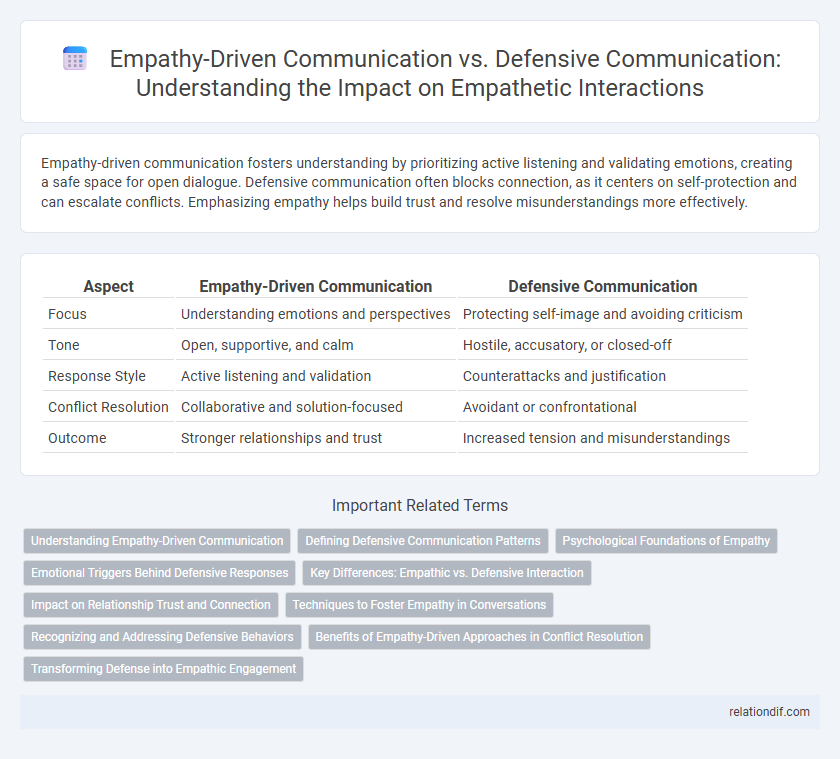Empathy-driven communication fosters understanding by prioritizing active listening and validating emotions, creating a safe space for open dialogue. Defensive communication often blocks connection, as it centers on self-protection and can escalate conflicts. Emphasizing empathy helps build trust and resolve misunderstandings more effectively.
Table of Comparison
| Aspect | Empathy-Driven Communication | Defensive Communication |
|---|---|---|
| Focus | Understanding emotions and perspectives | Protecting self-image and avoiding criticism |
| Tone | Open, supportive, and calm | Hostile, accusatory, or closed-off |
| Response Style | Active listening and validation | Counterattacks and justification |
| Conflict Resolution | Collaborative and solution-focused | Avoidant or confrontational |
| Outcome | Stronger relationships and trust | Increased tension and misunderstandings |
Understanding Empathy-Driven Communication
Empathy-driven communication prioritizes actively listening and validating others' feelings, fostering trust and deeper connections. This approach reduces misunderstandings and conflicts by addressing emotions and perspectives rather than reacting defensively. Emphasizing empathy enhances collaboration and emotional intelligence in both personal and professional interactions.
Defining Defensive Communication Patterns
Defensive communication patterns involve behaviors such as blaming, denying responsibility, and counterattacking, which hinder open dialogue and escalate conflicts. These patterns create barriers to understanding by prioritizing self-protection over genuine listening and emotional connection. In contrast, empathy-driven communication fosters trust and cooperation by encouraging vulnerability and acknowledging others' feelings without judgment.
Psychological Foundations of Empathy
Empathy-driven communication relies on understanding and sharing the emotions of others, rooted in mirror neuron activity and Theory of Mind, which facilitate emotional resonance and perspective-taking. Defensive communication, by contrast, activates the amygdala, triggering fight-or-flight responses that impair genuine emotional connection and increase psychological distance. This neuropsychological contrast underscores empathy's role in fostering trust and meaningful interpersonal interactions.
Emotional Triggers Behind Defensive Responses
Defensive communication often stems from emotional triggers such as fear, shame, or vulnerability, causing individuals to protect themselves rather than engage openly. Empathy-driven communication addresses these triggers by fostering understanding and validation, reducing emotional barriers. This approach promotes emotional safety, allowing for more honest and constructive dialogue.
Key Differences: Empathic vs. Defensive Interaction
Empathy-driven communication focuses on active listening, understanding emotions, and validating the speaker's perspective, fostering trust and openness. Defensive communication involves protecting oneself through denial, blame, or evasion, often escalating conflict and blocking meaningful dialogue. Key differences include emotional responsiveness, intention to connect, and the ability to resolve misunderstandings constructively.
Impact on Relationship Trust and Connection
Empathy-driven communication fosters trust and deepens connection by validating emotions and promoting understanding, whereas defensive communication often triggers conflict and erodes relational trust through blame and closed-off responses. When individuals engage with empathy, they create a safe environment that encourages openness, strengthening the emotional bond. In contrast, defensive reactions can increase distance and reduce the quality of interpersonal relationships due to perceived judgment and lack of emotional safety.
Techniques to Foster Empathy in Conversations
Empathy-driven communication employs active listening, open-ended questions, and reflective responses to create understanding and trust, contrasting sharply with the closed, reactive nature of defensive communication. Techniques such as acknowledging emotions, validating perspectives, and maintaining nonverbal cues like eye contact and nodding effectively promote emotional connection and reduce conflict. These strategies enhance interpersonal relationships by fostering a safe environment for honest and compassionate dialogue.
Recognizing and Addressing Defensive Behaviors
Recognizing defensive behaviors such as hostility, withdrawal, or avoidance is crucial for fostering empathy-driven communication, which prioritizes understanding and validating emotions. Addressing these behaviors involves active listening, open-ended questions, and creating a non-judgmental space that encourages honest expression. Empathy-driven communication reduces conflict intensity and promotes collaborative problem-solving by shifting focus from blame to shared feelings and needs.
Benefits of Empathy-Driven Approaches in Conflict Resolution
Empathy-driven communication fosters understanding and trust by allowing each party to feel heard and validated, which significantly reduces hostility and defensiveness in conflicts. This approach enhances emotional intelligence and promotes collaborative problem-solving, leading to more sustainable and mutually beneficial resolutions. Organizations adopting empathy-based strategies report higher employee satisfaction, reduced turnover, and improved overall team dynamics.
Transforming Defense into Empathic Engagement
Transforming defensive communication into empathy-driven engagement fosters deeper understanding by prioritizing active listening and validating emotions instead of reacting with resistance or blame. Empathy-driven communication encourages open dialogue, reduces conflict, and builds trust by addressing underlying concerns with compassion and clarity. This shift enhances relationships by creating a safe space where all parties feel heard and respected, promoting collaborative problem-solving.
Empathy-driven communication vs defensive communication Infographic

 relationdif.com
relationdif.com